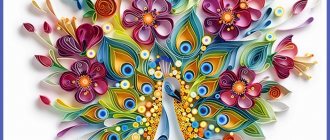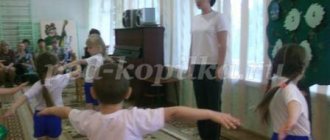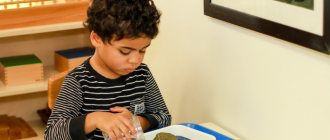How to conduct a lesson on familiarization with the outside world in the senior group of kindergarten
Moidodyr enters the group and says: I came to you today with drops of water to find out if you need water? (Children's answers). What do you need it for? (Children's answers). Do you, children, know where water comes from? (Children's answers). Moidodyr reads a poem:- In the wilderness of the forest, in the wilderness of green, Always shady and damp, In a steep ravine under the mountain A cold spring gushes out of the stones, Boils, plays and hurries, Spinning in crystal clubs, And runs under the branchy oaks Like molten glass.
This is where clean water comes from. The spring forms a stream, then the streams flow into lakes and rivers, from there a person directs it into pipes. Moidodyr invites the children to play, asks them riddles, and they guess in unison.
- I'm driving, driving, there are no traces, I look back - I'm afraid of death. (Water).
- It flows, flows - it won’t leak out, Runs, runs - it won’t run out. (River).
- I run like over pebbles, over pebbles ringing, From afar you will recognize me by the song. (Stream).
V.: And now, Moidodyr, the guys and I will show why we need water in kindergarten. Children with a teacher approach a natural corner (water flowers, loosen the soil in flower pots, wipe large leaves with a cloth, and spray small ones). The teacher invites preschoolers to name the plants in a natural corner. Q: Children, why do you need to loosen the soil? (Children's answers). Why do you need to water the plants? (Children's answers). What kind of water should you use? What do you use to loosen the soil? Why with chopsticks? What else needs to be done to make plants feel good and beautiful? (Children's answers). This is why we need water in this natural area, Moidodyr. Children with a teacher approach the play corner. Moidodyr asks: Why do you guys need water here? (Children's answers: wash toys). Why do you need to wash toys? (Children's answers). What else do you need water for, children? (Children's answers: wash your hands). Guys, show me how to wash your hands properly. One of the children shows the washing process: wet your hands, take soap, lightly soap your hands, put the soap in place, lather until rich foam, rinse with warm water, wipe dry with a towel. Moidodyr: Thank you guys, you explained to me once again how to wash your hands correctly. The teacher reads the proverb: Strength melts from simple water and soap and germs. Moidodyr reads a poem:
- I ask you, wash your hands and face more often, It doesn’t matter what kind of water, Boiled, spring water From a river, or a well, Or just rain! You must wash yourself in the morning, in the evening and during the day - before every meal, after sleep and before bed!
Moidodyr asks the children: Do you wash your hands often? And why? (Children's answers). The teacher asks: Do you know what our body is covered with? (Skin). What is she like? (Smooth, tender). What is skin needed for? (Protects us from germs). What needs to be done to prevent germs from entering the body? (Wash your hands, vegetables, fruits; close your mouth when you sneeze and cough; do not bite your nails; do not pick your nose; drink only clean water). Guys, now we know where the water comes from. (Spring - stream - river - lake - water supply). Let's go to the map of Tatarstan and look at it. What colors is the map painted in? (Children's answers). What color are rivers, lakes, and ponds depicted in? (Children's answers). What names of rivers do you know? (Children name the names of the big rivers of Tatarstan). And big rivers are formed from many small rivers and streams. Our republic is beautiful and rich, because there are rivers, lakes, and springs. So what is water? Let's do an experiment: take a jar and fill it with water. Now let’s pour this water into another jar. It takes the form of the vessel in which it is located. Hence the conclusion: water has no form. What else can you say about water? Take 2 glasses - one with water, the other with milk. Let's take a picture. Now let’s put a glass of milk in the picture. The picture is not visible. Now let’s put a glass of water in the picture. The picture is visible. Hence the conclusion: water is a transparent, colorless liquid. Now let's taste the water. It has no taste. Now let's smell what it smells like. It has no smell. Guys, what state is the water in? (Children's answers). In summer the water is liquid, in winter it is solid, and in spring it melts. And now, guys, Moidodyr has a surprise for you. (Brings in mineral water). What kind of water is this? Why do they drink mineral water? (Children's answers). Let's play the game "Healing Sounds" with you. Let's put some water in our mouth and say: “Mmmm.” The sound is made so that water is better absorbed in the body.
Introduction
This manual will help to successfully organize and carry out work to familiarize children 5–6 years old with the outside world (subject environment and phenomena of social life).
To make it easier for teachers to plan work on this section of the program, the content of the work is presented by topics. Each topic is covered: an approximate course of a lesson, activity or game is offered. The teacher can show creativity when planning lessons, include variable game and problem situations, which will make work with children even more successful and meaningful.
The study of each topic can be completed with a game task (puzzles, riddles, drawings, answers, etc.). Game tasks are presented in a workbook (Dybina O.V. I’m getting to know the world: Workbook for children 5–6 years old. - M.: TC Sfera, 2009).
Teachers should pay special attention to the fact that when getting acquainted with the outside world it is impossible to:
- limit yourself only to a monologue-story about objects, phenomena of reality - it is necessary to include as many actions as possible in your classes (sit on a chair, sofa, put on clothes and walk around in them, invite your mother, treat your grandmother, etc.);
– overload children with a large number of questions;
– reduce the organization of work with children only to the form of educational activities.
Familiarization with the surrounding world must be carried out in accordance with psychological characteristics, choosing adequate forms, means, methods and techniques of interaction in order to make this process more accessible and effective.
In the older group, familiarization with the surrounding world is carried out both in the form of games-activities, and in the form of a didactic game itself, when the game rule regulates the actions and relationships of children, and the correct solution of problems is the achievement of the goal of the game. When organizing and conducting games-activities, didactic games, it is important to create an atmosphere that allows each child to realize his activity in relation to the world around him.
Didactic games can be used both in joint activities of children and adults, and in independent activities of preschoolers, as well as to stimulate children’s activity in the process of learning about the world around them.
The manual presents additional material: options for game-activities, games, exercises, entertainment, intended for use in working with children outside of class, on a walk.
To familiarize children of the older group with the world around them (subject environment and phenomena of the surrounding world), 2 lessons per month are allocated.
The teaching staff of kindergarten No. 179 “Snowdrop” of the ANO DO “Planet of Childhood “Lada” of the city of Tolyatti, the head - Nadezhda Petrovna Palenova, the methodologist - Natalya Grigorievna Kuznetsova, took part in the development and testing of classes to familiarize adults with work.
The manual offers an approximate distribution of material for the academic year. The teacher can distribute the material in his own way, in accordance with the holidays of the month (October - Teacher's Day; February - Defender of the Fatherland Day, April - Cosmonautics Day, etc.) or depending on the availability of the material.
MAGAZINE Preschooler.RF
Lesson on familiarization with the environment “What is the man-made world”(for children of senior preschool age)
MUNICIPAL STATE PRESCHOOL EDUCATIONAL INSTITUTION OF A COMBINED TYPE "KINDERGARTEN "CRANE" OF NADYM"
Prepared by senior teacher Chidanova I.V. Nadym
SOFTWARE CONTENT:
- consolidate: children’s understanding of the diversity of the objective world; the ability to correctly name objects of the man-made world; the idea that every object has its own purpose and function
- learn to describe an object, isolating its features using a description algorithm
- expand children’s knowledge about inventions that facilitate human work in everyday life, making life convenient and comfortable; pay attention to the fact that they serve a person, and he must take care of them
- teach to establish cause-and-effect relationships between the phenomena of life around us and an object that helps a person more easily endure the inconvenience associated with this phenomenon
- develop curiosity, resourcefulness, and ingenuity.
PROGRESS OF THE CLASS:
- Guys, I have incredible news for you. Today an airship - an airship - made a successful landing. Our guests are Master Samodelkin and his friend Dunno. Their visit to us is not accidental. Master Samodelkin really hopes for our help. He asks for help to explain to Dunno what a man-made world is. Can we help? (yes!) Well, we’ll go to the country “Man-Made World” on an airship.
— Boarding pass will be a word that refers to the man-made world.
(children say the word and go to their chairs)
“And we’ll give Dunno a pen and a notepad, let him write down all the most important things.”
Prepare to fly! Fasten belts! Attention! 5.4, 3, 2, 1!
Whip – whack – whack!
(children, when shown by an adult, perform a finger warm-up)
— The airship moves depending on the direction and strength of the wind.
“Blow low, blow close, blow high, blow far”
(children perform breathing exercises, music plays)
— Our flight went as usual, is the crew in a good mood? We arrived at the given coordinates. Big or small country “Man-made world” ? How did you understand this? (picture of a big city) Many different buildings.
—What kind of houses do you see? Show and name them correctly (single-story, multi-story).
- What are the houses made of? (made of brick - brick, made of wood - wooden, etc.) Show.
— What can’t you imagine being at home without? (without roof, walls, windows, doors)
—Who builds the buildings? For whom? (purpose - residential building, school, kindergarten, circus, sports palace, etc.) Why?
- Where can we see such houses? (in a village, city)
- So, which world do the houses belong to? Why?
- Look at the flow of cars moving through the city streets. Let's count how many cars are going to the right, to the left (orientation in space)
— Each machine does its job. Some are responsible for transporting people. These are taxis, buses, trolleybuses, trams (children name and show) Others transport goods.
D/I “Name it in one word”
— Name in one word a machine that:
Carries milk - ..., mixes concrete - ..., carries water - ..., crushes stones - ..., carries bread - ...
— Guys, tell me, are there cars that everyone gives way to? Name them correctly. Special vehicles - ambulance, police, fire truck.
- Let's find out what Dunno wrote in his notebook.
D/I “Correct the sentences”
The house pulled up next to the car.
The gas ran out because the car stopped.
The car drives along a city street.
The passenger takes a ticket from the conductor for the bus.
— Who invented and made all these machines? For what? What world does technology belong to?
PHYSICAL MINUTE
— Thank you, Dunno, for the fun warm-up! We didn’t even notice how we ended up at the store window. Look carefully and tell me what it is called (clothes - shoes).
- Tell me, what do we call clothes? Shoes?
D/I “Guess what I’m talking about”
Back, sleeves, front, cuffs, collar, pockets, buttons - shirt
Pants legs, pockets, button, lock, belt - trousers
Sleeves, pockets, zipper, fur lining, collar - coat, fur coat
— How can you tell about shoes?
— Let's remember the materials from which clothes and shoes are made (chintz, knitwear, drape, cotton; leather, wool, fur).
- Name the clothes that are knitted and sewn.
- Who sews clothes? For what? Clothes and shoes are objects of which world?
- What is this strange drawing in front of us? Look carefully, maybe you can guess.
— Master Samodelkin led us to the alley of tools and materials (picture)
— Guys, how many of you know why people need these and many other tools? (to perform labor actions and make many necessary and useful items).
D/I “What are we doing with what?” (ball game)
We dig the ground - with a shovel; We chop wood - with an ax; We hammer in nails - with a hammer; We unscrew or tighten a bolt - with a screwdriver
We cut boards with a saw, we cut paper with scissors, we pierce a hole with an awl, we write in a notebook with a pen.
We draw a table with a ruler, we paint a fence with a brush, we sew a dress with a needle
— If an object is made of rubber, it is rubber (they give an example), if it is made of plastic, it is plastic, if it is made of paper, it is paper, if it is made of metal, it is metal, if it is made of wood, it is wooden, if it is made of polyethylene, it is polyethylene, if it is made of glass, it is glass.
“We didn’t even notice how we ended up on the Square of Inventions.”
“There are objects with which a person works, and there are also objects that make a person’s work easier.” Guess them together with Dunno.
A house on legs, with a window in the middle. The window will light up - a movie (TV) will appear.
Walks, wanders along the carpets, moves his nose in the corners. Wherever I went, there was no dust. Dust and rubbish are his lunch. He willingly inhales dust, does not get sick, does not sneeze (vacuum cleaner)
In Linen Country A steamboat floats along the Sheet River, back and forth. And behind it there is such a smooth surface - Not a wrinkle to be seen (iron)
They knock, they knock - They don’t tell you to be bored, They go, they go - And everyone is here and there (clock)
Admire, look - the North Pole is inside! Snow and ice sparkle there, Winter itself lives there, This winter is forever for us Brought from the store (refrigerator
- Name what other human inventions you know. What are they for (dishwasher, washing machine, microwave oven, hair dryer, mixer, food processor, heater, etc.)?
— We are returning to the airship along the Street of Comparisons
D/I “It’s similar - it’s not similar”
Horse - bicycle Tree - chair Airplane - bird Clock - rooster
— Traveling around the country The man-made world is coming to an end. It's time for us to return. Do you think Dunno now understands what a man-made world is? How do you understand this yourself? (children's answers) That's right, what a person made with his own hands or with the help of tools, what improves, facilitates or makes his life comfortable is called the man-made world.
“Man-Made World” more than once .
Summary of the lesson. Assessment of children's activities.
As a souvenir of the trip, the children receive coloring books with objects from the man-made world.
Bibliography
- Dybina O.V. Man-made world: scenarios of game-activities for preschoolers. Creative. Moscow, 2002
- Volchkova V.N., Stepanova N.V. Lesson notes for the senior group of kindergarten. Cognitive development. Practical guide for educators and methodologists of preschool educational institutions. Shopping center "Teacher" . Voronezh, 2005
- Kibitina I.I. Preschoolers about technology. Moscow "Enlightenment" , 1991.
| Next > |



